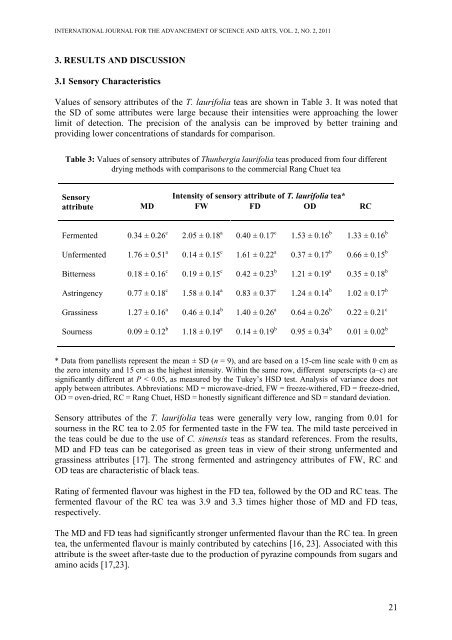Analysis and Evaluation of Sensory Properties and ... - UCSI University
Analysis and Evaluation of Sensory Properties and ... - UCSI University
Analysis and Evaluation of Sensory Properties and ... - UCSI University
Create successful ePaper yourself
Turn your PDF publications into a flip-book with our unique Google optimized e-Paper software.
INTERNATIONAL JOURNAL FOR THE ADVANCEMENT OF SCIENCE AND ARTS, VOL. 2, NO. 2, 2011<br />
3. RESULTS AND DISCUSSION<br />
3.1 <strong>Sensory</strong> Characteristics<br />
Values <strong>of</strong> sensory attributes <strong>of</strong> the T. laurifolia teas are shown in Table 3. It was noted that<br />
the SD <strong>of</strong> some attributes were large because their intensities were approaching the lower<br />
limit <strong>of</strong> detection. The precision <strong>of</strong> the analysis can be improved by better training <strong>and</strong><br />
providing lower concentrations <strong>of</strong> st<strong>and</strong>ards for comparison.<br />
Table 3: Values <strong>of</strong> sensory attributes <strong>of</strong> Thunbergia laurifolia teas produced from four different<br />
drying methods with comparisons to the commercial Rang Chuet tea<br />
<strong>Sensory</strong><br />
Intensity <strong>of</strong> sensory attribute <strong>of</strong> T. laurifolia tea*<br />
attribute MD FW FD OD RC<br />
Fermented 0.34 ± 0.26 c<br />
Unfermented 1.76 ± 0.51 a<br />
Bitterness 0.18 ± 0.16 c<br />
Astringency 0.77 ± 0.18 c<br />
Grassiness 1.27 ± 0.16 a<br />
Sourness 0.09 ± 0.12 b<br />
2.05 ± 0.18 a<br />
0.14 ± 0.15 c<br />
0.19 ± 0.15 c<br />
1.58 ± 0.14 a<br />
0.46 ± 0.14 b<br />
1.18 ± 0.19 a<br />
0.40 ± 0.17 c<br />
1.61 ± 0.22 a<br />
0.42 ± 0.23 b<br />
0.83 ± 0.37 c<br />
1.40 ± 0.26 a<br />
0.14 ± 0.19 b<br />
1.53 ± 0.16 b<br />
0.37 ± 0.17 b<br />
1.21 ± 0.19 a<br />
1.24 ± 0.14 b<br />
0.64 ± 0.26 b<br />
0.95 ± 0.34 b<br />
1.33 ± 0.16 b<br />
0.66 ± 0.15 b<br />
0.35 ± 0.18 b<br />
1.02 ± 0.17 b<br />
0.22 ± 0.21 c<br />
0.01 ± 0.02 b<br />
* Data from panellists represent the mean ± SD (n = 9), <strong>and</strong> are based on a 15-cm line scale with 0 cm as<br />
the zero intensity <strong>and</strong> 15 cm as the highest intensity. Within the same row, different superscripts (a–c) are<br />
significantly different at P < 0.05, as measured by the Tukey’s HSD test. <strong>Analysis</strong> <strong>of</strong> variance does not<br />
apply between attributes. Abbreviations: MD = microwave-dried, FW = freeze-withered, FD = freeze-dried,<br />
OD = oven-dried, RC = Rang Chuet, HSD = honestly significant difference <strong>and</strong> SD = st<strong>and</strong>ard deviation.<br />
<strong>Sensory</strong> attributes <strong>of</strong> the T. laurifolia teas were generally very low, ranging from 0.01 for<br />
sourness in the RC tea to 2.05 for fermented taste in the FW tea. The mild taste perceived in<br />
the teas could be due to the use <strong>of</strong> C. sinensis teas as st<strong>and</strong>ard references. From the results,<br />
MD <strong>and</strong> FD teas can be categorised as green teas in view <strong>of</strong> their strong unfermented <strong>and</strong><br />
grassiness attributes [17]. The strong fermented <strong>and</strong> astringency attributes <strong>of</strong> FW, RC <strong>and</strong><br />
OD teas are characteristic <strong>of</strong> black teas.<br />
Rating <strong>of</strong> fermented flavour was highest in the FD tea, followed by the OD <strong>and</strong> RC teas. The<br />
fermented flavour <strong>of</strong> the RC tea was 3.9 <strong>and</strong> 3.3 times higher those <strong>of</strong> MD <strong>and</strong> FD teas,<br />
respectively.<br />
The MD <strong>and</strong> FD teas had significantly stronger unfermented flavour than the RC tea. In green<br />
tea, the unfermented flavour is mainly contributed by catechins [16, 23]. Associated with this<br />
attribute is the sweet after-taste due to the production <strong>of</strong> pyrazine compounds from sugars <strong>and</strong><br />
amino acids [17,23].<br />
21





